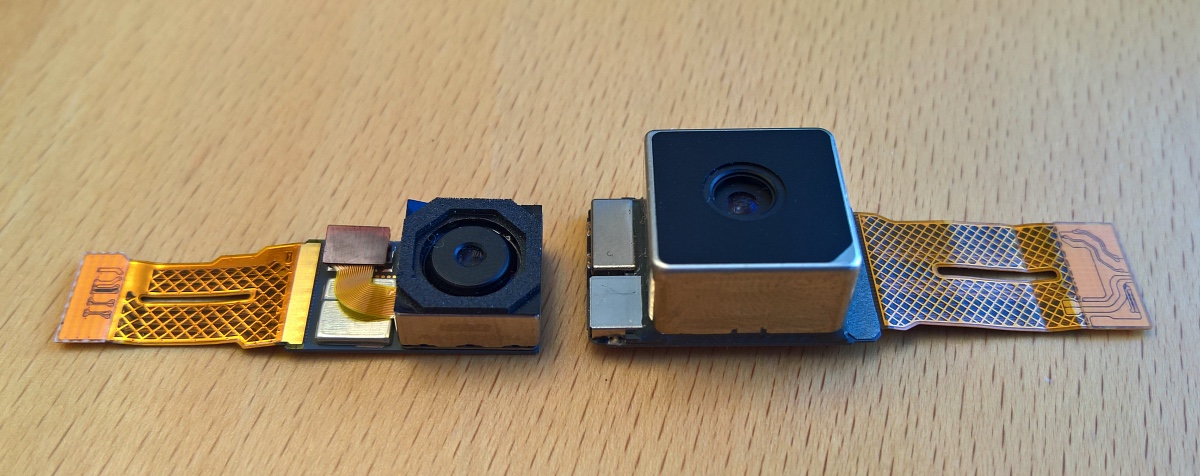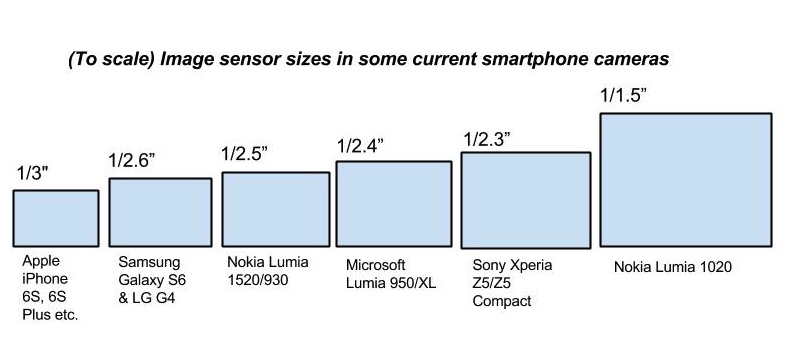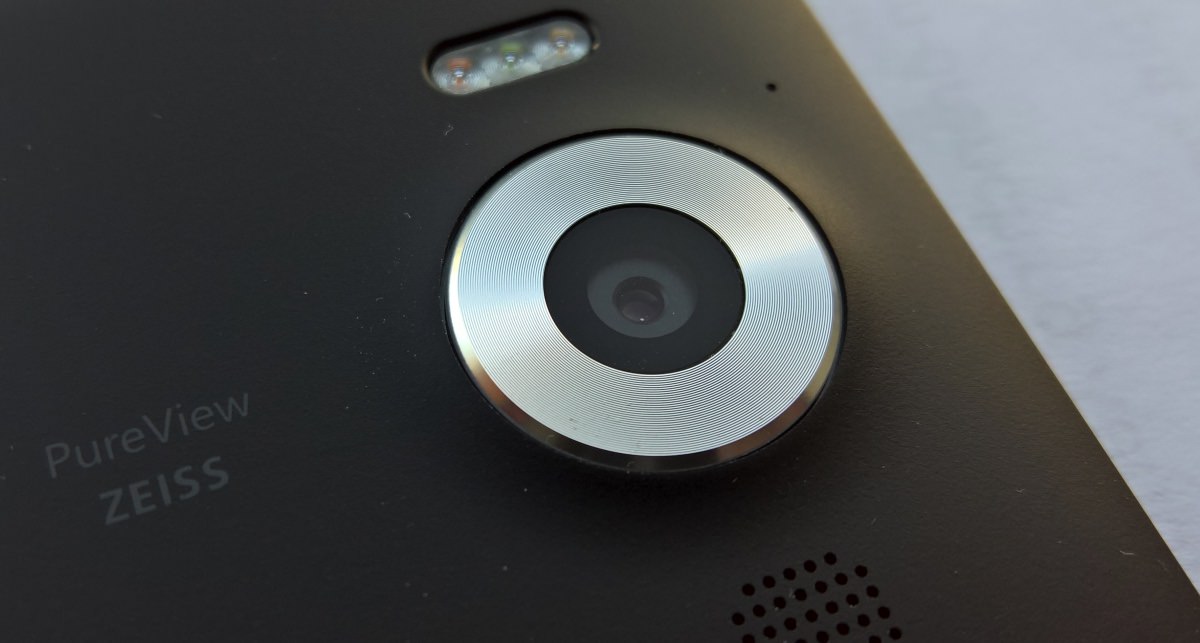
credit Dávid Detkó
Right, let's unpack the photo above. On the left is the camera module from the Lumia 950 and 950 XL, on the right is that from the Lumia 1020. The first thing to notice is the difference in thickness. Yes, the sensor is smaller (of which more in a moment), and so the laws of physics will allow a thinner module, but there are also improvements in the OIS used, with all mechanisms from the Lumia 830 onwards (that was 'third gen', this is 'fifth gen') making sure that they didn't add to the height of the module. You can tell this from the physical dimensions and from the change in appearance - the optical stack is being manipulated differently.

Secondly, the sensor is indeed smaller, at 1/2.4", allowing more compact light paths. Interestingly, this is similar to where the competition has ended up, as you can see from the chart below:

There's much that's similar between the Lumia 930 and 950/XL camera sensors, both using 1.1 micron BSI pixels, but the latter adding in phase detection auto-focus technology and possibly accounting for the slight extra girth. However, sensor technology has improved quite a bit in the intervening couple of years and there's now higher signal to noise ratio, improving detail and reducing noise. And, in low light, in theory letting you get away with shorter exposures and better capture of moving subjects (e.g. people).
Why not 41MP still?
There's one obvious question, and it has been asked dozens of times in the comments on the articles on AAWP, and that's "Why not use a 41MP, 1/1.5" sensor again?" if Microsoft wanted to create the ultimate camera in their flagships? One answer, equally obviously, is that the thickness difference pictured at the top would dominate the hardware too much. If you look at the back of the 950 and 950 XL closely, there isn't really a camera 'bump' at all - merely hardware detailing that accentuate the camera and give prominence to the idea that it's important.

The 950 camera - plenty of visual accentuation, but the actual physical 'bump' is only a millimetre or so....
Secondly, there's the matter of image processing and speed. The Lumia 1020, admittedly with a slower S4 main processor, was legendarily slow at saving each captured photo, leading to a shot to shot time of around four seconds. For a typical shot in 16:9, 34 million pixels were being captured, saved, oversampled and saved again at 5MP. Even with the reduction in resolution to 16MP (in 16:9) and with today's much faster processors, we'd still be looking at up to a half a second to get all this done.
Which is no use at all when trying to achieve the tricks of the modern age, such as native HDR/Rich Capture, where shots have to be taken effectively instantaneously. The solution, implemented first in Lumia Camera 5.x on the likes of the Lumia 930 and 1520, was to offload all the image processing and saving off to other processor cores, leaving the main core free to handle the camera user interface and let the user keep shooting. So, for example, a couple of Rich Capture shots could be snapped, with up to three exposures each, all inside a second, and the extra cores in the multi-core processor can be set to work in the background, saving images, constructing the necessary intermediate files for Rich Capture blending, and so on.
If it were just a case of oversampling, as on the 1020, then yes, a 34MP oversample to 8MP on a hypothetical Lumia 1060 (or whatever) with a Snapdragon 810 (say) might only involve a second's processing and the new super-camera-phone might be a goer. But the requirement for Rich Capture and HDR (the latter now used on all the competition) is a game changer. In fact, in addition to the Rich Capture blending operations, the fact that processing can go on for longer, in the background while the user carries on shooting or doing something else on the phone, has led Microsoft to implement extra processing stages, with multi-shot exposures for noise reduction, with analysis of scenes for subject motion, with extra colour analysis and correction. As we've observed on the Lumia 950 range, these operations all happen in the background (annoying if you want to go back immediately to review a host, but hey....) in the 'Applying finishing touches' stage, and can be up to 10 seconds per photo. For 16MP shots. If 34MP shots were involved, the processing times would double.
As we saw in my hands-on tests, overall quality and detail is now good enough from the 1/2.4" sensor (and its processing chain) that for most use cases it exceeds that of the Lumia 1020. And is demonstrably good enough - the law of diminishing returns would apply if effort was made to create a Lumia 1060 - its image quality would be astounding, but (Xenon flash apart for some indoor shots) I'll warrant that almost no user would notice the difference in results from the Lumia 950, yet they'd certainly notice the extra 5mm of thickness (of camera bump) in their pocket.
If this sounds like apologetics for Microsoft then I'm sorry - my point here is that the PureView concept and Nokia's experiments with pro-level optics, OIS and oversampling have all led to this point, where sensor, optics, OIS, chipset and algorithms are all finely balanced. The core premise of PureView, that of using a high resolution sensor to create purer low resolution images and to allow for lossless zoom still apply, albeit not as dramatically as on the Nokia 808 and Lumia 1020 - because they're not needed as much as before.

The 1020 camera module broken down, cut through and showing the underlying sensor. This is the 'old' tech - I wonder who long it'll be before Microsoft or a third party shows us a dismantled 950 camera module?
However...
So the hardware's 'there', I contend. A perfect balance of technology. Even the flash is now triple LED and performing better than LED flash has any right to, to my surprise. What's not finished yet is the software - in this case Windows 10 Camera. I've been keeping a watch on what's still to come (and nagging the Microsoft imaging team about all of it) and here's the list:
- some indication on screen of how much zoom has been applied - at the moment it's far too easy to go beyond the 2x lossless PureView zoom into blocky, artefact-strewn digital zoom. An on-screen indicator or a detent of some kind would be very helpful. Sony does this on its Xperia flagships in the camera UI, for example.
- a way of forcing Rich Capture 'on'. This has been confirmed to be 'coming'. At the moment, the 'automatic' mode often stays 'off' far too often.
- LED flash sequencing could do with optimising to reduce 'red eye'. It's very prevalent at the moment (triple LED being very bright!) and a pre-capture red-eye reduction flash option would be very helpful in avoiding having to go back into each photo afterwards in Lumia Creative Studio, just to take out the red eye!
- algorithmic reduction in wind noise. It's currently appalling when shooting videos and I suspect that the four-mike arrays, together with some clever software, could significantly filter wind out of an audio soundtrack.
- also on the video side, Dolby Digital audio needs reintroducing, plus stereo capture needs re-enabling for Windows 10 Camera on the older devices like the 930 and 1520.
I'm sure you can dd your own shopping list of things to add/fix in Windows 10 Camera. Still, at least the basics are all in place. As the old song used to say, 'Things can only get better'.
_________
Comments welcome, do you agree that the 950's imaging hardware is 'PureView evolved' and a good balance of technology all round?
